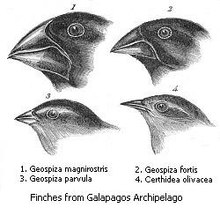
| Part of a series on |
| Evolutionary biology |
|---|
 |
Divergent evolution or divergent selection is the accumulation of differences between closely related populations within a species, sometimes leading to speciation. Divergent evolution is typically exhibited when two populations become separated by a geographic barrier (such as in allopatric or peripatric speciation) and experience different selective pressures that cause adaptations. After many generations and continual evolution, the populations become less able to interbreed with one another.[1] The American naturalist J. T. Gulick (1832–1923) was the first to use the term "divergent evolution", with its use becoming widespread in modern evolutionary literature.[2] Examples of divergence in nature are the adaptive radiation of the finches of the Galápagos, changes in mobbing behavior of the kittiwake, and the evolution of the modern-day dog from the wolf.
The term can also be applied in molecular evolution, such as to proteins that derive from homologous genes. Both orthologous genes (resulting from a speciation event) and paralogous genes (resulting from gene duplication) can illustrate divergent evolution. Through gene duplication, it is possible for divergent evolution to occur between two genes within a species. Similarities between species that have diverged are due to their common origin, so such similarities are homologies.[3]
- ^ "Sympatric speciation". Retrieved 2 February 2016.
- ^
 Gulick, John T. (September 1888). "Divergent Evolution through Cumulative Segregation". Journal of the Linnean Society of London, Zoology. 20 (120): 189–274. doi:10.1111/j.1096-3642.1888.tb01445.x. Retrieved 26 September 2011. (subscription required)
Gulick, John T. (September 1888). "Divergent Evolution through Cumulative Segregation". Journal of the Linnean Society of London, Zoology. 20 (120): 189–274. doi:10.1111/j.1096-3642.1888.tb01445.x. Retrieved 26 September 2011. (subscription required)
- ^ Zuckerkandl, EMILE; Pauling, LINUS (1965-01-01), Bryson, Vernon; Vogel, Henry J. (eds.), "Evolutionary Divergence and Convergence in Proteins", Evolving Genes and Proteins, Academic Press, pp. 97–166, ISBN 978-1-4832-2734-4, retrieved 2024-03-24